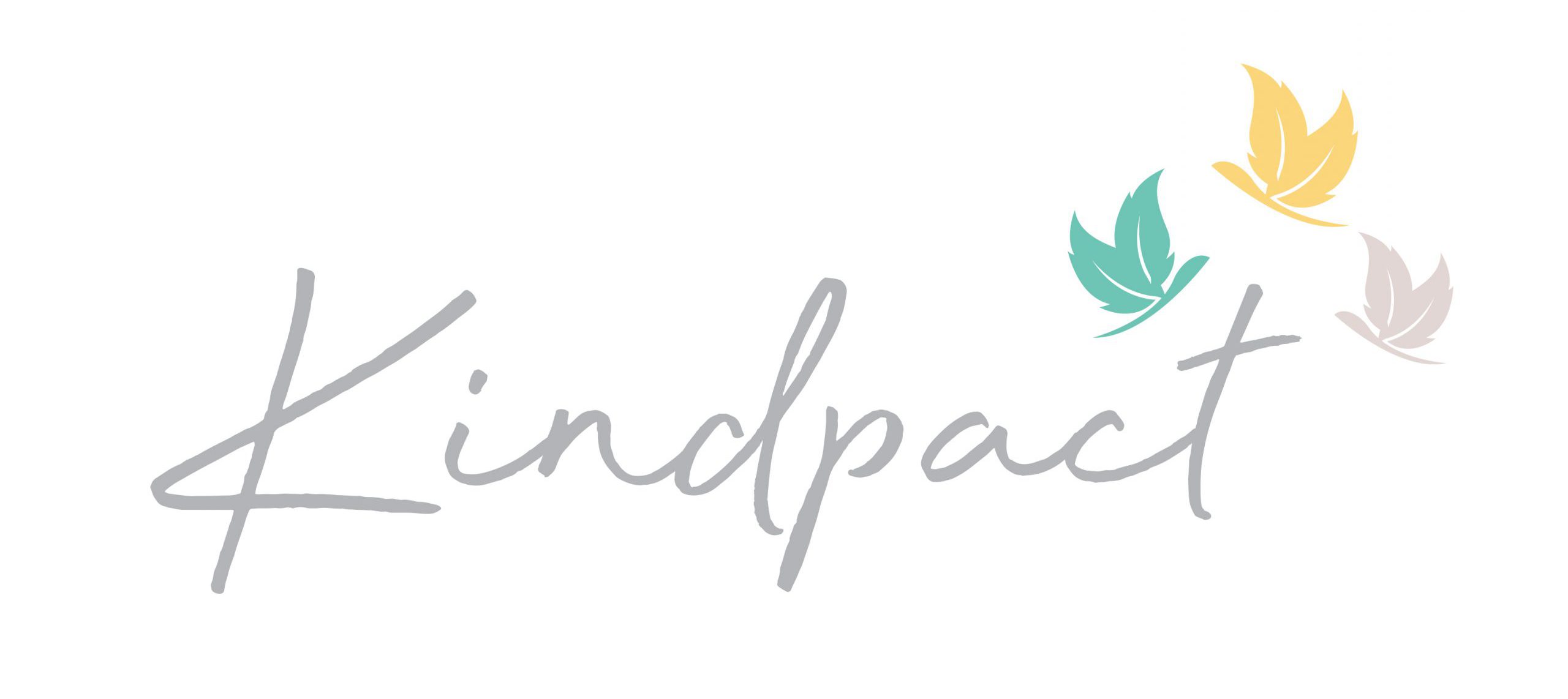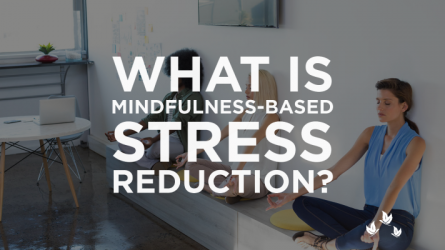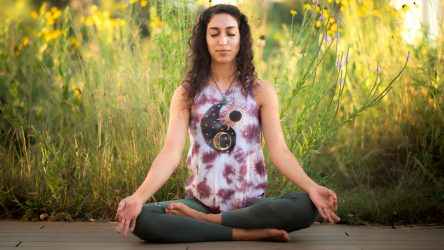This post may include affiliate links. Affiliate links provide us a small commission if you make a purchase from the link. Your support helps us making yoga, mindfulness, and stress reduction programs more accessible.
It’s easy to get so caught up in our head that all our actions process automatically, with our minds paying very little attention to the experience at hand. You’ve probably noticed that when you’re doing chores or driving or eating,you have no clear memory of the experience because your mind gets so preoccupied with thoughts of the past or future. Cultivating mindfulness is the practice of bringing our attention to the present moment and everything that it includes. It is the state of being aware of your situation, thoughts, and sensations without reacting to them or forming judgements about them. You can practice mindfulness at any point of your waking day. To establish a strong foundation, it is useful to have a dedicated time for cultivating your meditation practice. However, soon you will be able to bring mindfulness into every part of your day when you’re brushing your teeth or eating or having a conversation. As its rapidly growing popularity proves, mindfulness is a powerful tool to improve the quality of your life.
Benefits of Mindfulness Meditation
Reduces stress and improves mood
The process of forming judgments attaches value to our thoughts and experiences. This creates attachment if the value attached is good or aversion if the value attached is bad. Attachment and aversion are always rooted in either the past or future. Thus, mindfulness, by bringing us into the present moment, can help us overcome attachment and aversion to our situation, thereby making us feel happier and less stressed. Mindfulness-based stress reduction therapy is becoming an increasingly popular treatment for anxiety and depression.
Makes experiences more enjoyable
By tuning into your senses during seemingly mundane tasks like driving or bathing, you will notice that you become less frustrated or bored and begin to enjoy the experience more fully. The quality of mindfulness will make you more focused and efficient at everything you do which in turn will make your activities more fulfilling.
Improves cardiovascular health
Mindfulness meditation, if practiced regularly, reduces the stimulation of the body’s stress response. In turn, it activates the parasympathetic nervous system, lowering heart rate and blood pressure. This improves cardiovascular function and is the reason mindfulness makes you feel less anxious. Meditation also increases the heart rate variability (HRV) which reduces the risk of heart attack and stroke.¹
Reduces chronic pain and increases tolerance to pain
Brain images of mindfulness practitioners show that they have less activation in the part of their brain that receives pain impulses. Patients with chronic pain, through mindfulness treatment have been able to reduce their pain to the extent that they can partially or completely wean off their pain medication.² The ability to focus, relax the body and be aware of bodily sensations boosts a person’s mood and clarity which helps them handle pain better.
What Mindfulness Meditation is Not
It does not deliver instant happiness
Many beginner meditators expect to feel instantly better after a meditation session and are disappointed to find that they are instead bored, frustrated and sometimes even unhappy. For a mind that is constantly distracted, it can be hard to sit still and be present with unpleasant thoughts and sensations. The mind is like a muscle that needs to be worked out regularly over a long period of time. The benefits of meditation are guaranteed to someone who enters without expectation and stays committed to a consistent practice.
It is not about becoming thoughtless
It is a common misconception that the aim of meditation is to completely rid the mind of thought. This is very difficult and is not the aim of the practice. Instead, mindfulness is about becoming aware of the thoughts and sensations as they arise without indulging in them. It is normal to get distracted during mindfulness but the training lies in the process of becoming aware that you are distracted and gently bringing yourself back to your practice.
It is not a time-consuming practice
Many people, with busy schedules, believe they simply don’t have the time to meditate. It is thought that meditation requires hours of daily practice. This is simply not true. Even 5 minutes a day can have a noticeable impact on your state of body and mind. As a beginner, it is necessary to set small, achievable goals and as your mind settles into it, you will find that you can effortlessly sit for longer periods of time. Moreover, it is not necessary to practice mindfulness on a meditation cushion. Once you understand what it means to stay present, you can practice mindfulness at any point in your day even when you’re engaged in an activity.
Trauma-Sensitive Mindfulness Meditation
Trauma sensitive mindfulness meditation is, simply put, a mindfulness practice with a working understanding of trauma. This includes recognizing the signs of trauma, responding to them effectively and taking steps to ensure that they don’t get worse.
Unaddressed trauma often actively lives on in the body and when triggered, surfaces as panic and helplessness. The practice of mindfulness asks us to become aware of all our internal sensations and it can be very difficult to cope with the increased awareness of one’s trauma. This is not in itself a bad thing. Mindfulness, over time, has proven to be extremely effective at managing trauma. The ability to become aware of a sensation without indulging in it can help a person gain distance from their traumatic experience. However, this can only happen with mindfulness meditation that is specially designed to address trauma. Trauma-sensitive mindfulness meditation adapts and modifies regular mindfulness practices under the controlled environment of a trained guide to safely allow a person to approach their trauma and release it in a healthy way.
An excellent resource to learn more about trauma-sensitive mindfulness is David Treleaven’s book, Trauma-Sensitive Mindfulness: Practices for Safe and Transformative Healing.
Getting Started with Mindfulness Meditation
Set aside a dedicated time for daily practice
As mentioned, it is enough to practice just 5 minutes a day to receive the benefits of mindfulness meditation. However, it is necessary to practice consistently. Set aside a dedicated amount of time each day to meditate where you can be undisturbed.
Find the right posture
There are many different ways to meditate. You could meditate cross-legged on the floor with a straight spine. If this is inaccessible, you can sit on a chair with your hands resting gently on your thighs. Before you begin, make sure you aren’t holding any tension in your back or neck. You should be comfortable enough to sit for extended periods of time while not so comfortable that you fall asleep while meditating. It is easier to establish unbroken focus if you close your eyes but this is not necessary.
Bring your attention to the breath
The most commonly practiced form of mindfulness meditation focuses on the breath since it is an effective, repetitive anchor. Bring your attention to the nostrils or the stomach and notice the sensation of breathing in and out. Stay with the breath as it moves without trying to affect it in any way. Whenever you find you’ve become distracted, patiently bring your attention back to the journey of the breath.
Find a guide
While it is perfectly possible to start a mindfulness meditation practice by yourself, you will benefit deeply from having a friend, teacher, or book that can help you on your journey. Meditation can be confusing and difficult at first, so it is helpful to have someone to guide you and teach you the philosophy and history behind the practice.
References
Harvard Health Publishing. Mindfulness can improve heart health. February 2018. 19 January 2021.
Mayo Clinic Health System. Use mindfulness to cope with chronic pain. 25 September 2020. 19 January 2021.




